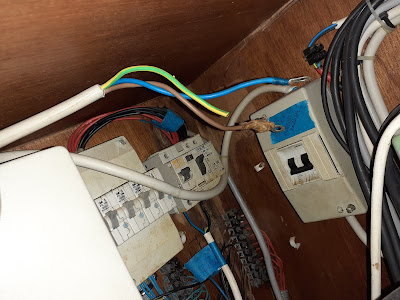I always go back to my Boat Safety Scheme Training when it comes to electrics on older Yachts. Cables can overheat if the cabling on your boat is not sufficient to carry the current. To minimise this risk the cables must be capable of carrying the current and be of the right construction and grade. New electrical installations must use multi-stranded conductors, since solid conductors can easily break where there is high vibration or repeated flexing of a cable.
Fuel, water, heat, oils and other chemicals can all cause damage to your cables, reducing the effectiveness of the insulation and increasing the risk of cables overheating - which could cause them to short-circuit, spark and start a fire. Exposed 240V wiring (see image) can also give people on your boat an electric shock. To reduce these risks all cables must be properly insulated and/or sheathed with a resistant material.
To prevent damage caused by vibration, cables must be securely fixed at approximately 300mm (12ins) intervals, or run in a pipe or trunking which is adequately supported. Also, to reduce the chance of damage to the cables, they must be kept away from other heat sources such as exhaust outlets, cookers and stoves.


Cylinder valves, regulators and other components in the lockers can be damaged if boating equipment, such as mooring pins, are thrown in. Damaged gas components could quickly leak, leading to a serious fire or explosion potentially. To minimise the risk of this happening cylinder lockers must have a lid or cover to protect the cylinders, low pressure regulators and associated equipment from mechanical damage. Note: This was from a Survey last week with the gas cylinder stowed next to the winch solenoid..... these things spark!
If you have electrical devices fitted in a compartment containing gas or petrol there's a danger of the flammable gases being ignited by hot components or electrical discharges and causing a fire or an explosion. To minimise the risk of this happening the electrical devices must be ignition-protected to meet BS EN 28846.
Another Yacht from last weeks assignment's. To minimise the risk of damage to cables, and to allow a visual inspection of the installation, main circuits must be installed above bilge water level. Bilge water level can usually be determined by the presence of a 'tidemark', the position of the bilge pump or its inlet, or the level at which the float switch is set.
Thinking about buying a Yacht in Greece and need Help? Drop me an email today.
A rapid response – quotations within the same day… often within the hour!





No comments:
Post a Comment
Hi, how can I help?